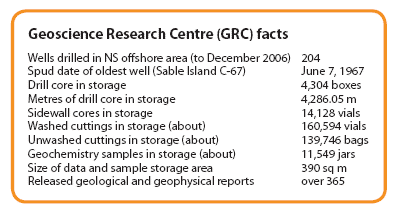NOVA SCOTIA CANADA: THE NEXT PLAY
Complete well history and subsurface data on-site at Geoscience Research Centre
The Geoscience Research Centre (GRC), located in Dartmouth, N.S. (across from Halifax), along with a recently established online Data Management Centre (DMC), serve as the physical archive for geological and geophysical information and services for the Nova Scotia offshore area.
Subsurface samples from 204 offshore petroleum exploration and development wells drilled by industry in Nova Scotia offshore area are stored at the facility. The facility also curates a hard-copy inventory and microfiche record of geological, well history and geophysical information.
Over 350 released geological and geophysical reports covering the Nova Scotia offshore area are available for inspection. There are about 204 well history reports for viewing for the Nova Scotia offshore area. The paper and microfilm records vary in completeness and quality depending on the operator and the program vintage.
The facility archives all geological and geophysical reports, well site survey reports, and several types of subsurface samples. The GRC prepares core samples and cuttings for the extraction of microfossils and the processing of palynological residues. It also maintains a micropaleontology data bank and curate cores, cuttings, prepared residues and picked slides for examination by academic, industry and government scientists.
Unwashed cutting samples are kept in plastic-lined cloth bags and geochemistry samples are stored in one-litre plastic jars. Bulk unwashed cutting samples, geochemistry jars, and all drill core are stored in cardboard boxes which, in turn, are stored on racked pallets. Washed cutting samples are in 25-ml plastic vials arranged in trays, which are stored in steel cabinets. Sidewall cores are stored in 25-ml plastic vials in steel storage cabinets, as are the collections of picked micropaleontology and palynology slides.

Samples from well site seabed surveys are also curated. Fluid samples are also archived and are stored in 1 litre glass jars. Recent fluid samples are stored in a flammable goods freezer. A binocular microscope and other sample examination aids are available to users on request. Requests to sample materials in storage must be submitted, in writing, with an outline of the type of study to be conducted. If permission to sample is granted, the size of sample is determined with reference to the amount remaining and also the nature of the study. The amount of sampling and the degree of duplication of studies is strictly regulated.
The facility’s laboratory is able to process samples from wells for extraction of micropaleontological material. Access to the laboratory is provided for users wishing to prepare their samples taken for palynology processing, vitrinite reflectance, petrology, etc. The laboratory also contains equipment for petrological determinations, which includes a rock saw to sample cores for thin sections.
Data Archive: Disclosure of technical data
Sections 122 and 121, respectively, of the federal and provincial offshore legislation deal with the confidentiality and disclosure of information. General information on a well, including its name, operator, classification, location, identity of the drilling unit, depth and operation status of the drilling program, may be obtained from the Board on a current basis.
Information or documentation in respect of an exploratory well is held confidential for two years following the well termination date. The confidentiality period for a delineation well is two years following the termination date of the discovery well on the same prospect, or 90 days following the well termination date of the delineation well, whichever is longer. For a development well, the confidentiality period is two years following the termination date of the discovery well on the same prospect, or 60 days following the termination date of the development well, whichever is longer. 
|



